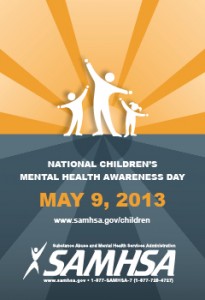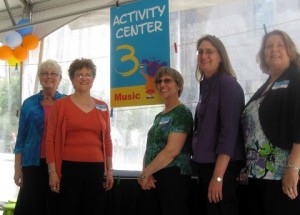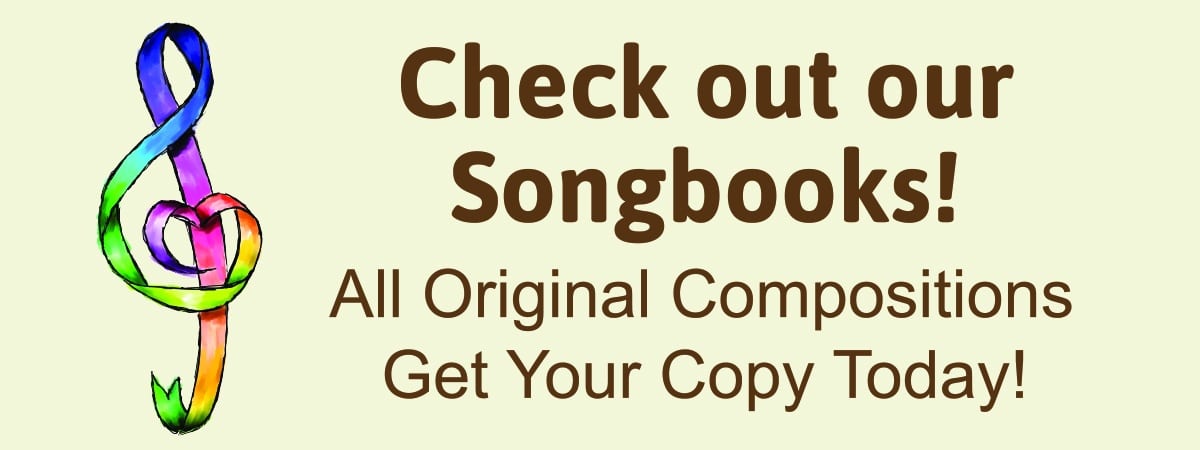Thursday, May 9 is National Children’s Mental Health Awareness Day sponsored by the Substance Abuse and Mental Health Services Administration (SAMHSA) of the U.S. Department of Health & Human Services.
National Children’s Mental Health Awareness Day is a key strategy of the Caring for Every Child’s Mental Health Campaign, which is part of the Public Awareness and Support Strategic Initiative of SAMHSA. The initiative is designed to raise awareness about the importance of children’s mental health and send a message that positive mental health is essential to a child’s healthy development from birth.
Communities around the country participate by holding their own Awareness Day events, focusing either on the national theme, or adapting the theme to the populations they serve.
Several years ago I had the honor to travel to Washington D.C. to represent Music Therapy during this annual SAMHSA event along with music therapy colleagues Ronna Kaplan, Marcia Humpal, Beth McLaughlin and members of the AMTA National Office. We not only spoke about music therapy and mental health in early childhood, we also demonstrated music therapy in action with groups of children from local children’s centers. For more information on the SAMHSA event visit http://www.samhsa.gov/children 
This past week, I had the opportunity to present at a multi-disciplinary conference on Mental Health and Early Childhood at Molloy College on Long Island, New York. The panel included representatives from early education, special education, psychology, social work, and nursing as well as music therapy.
I thought you might like to have a copy of my speech to use this week to support your efforts on behalf of mental health for all young children and their families. Please feel free to use my words as you advocate for them and for the importance of music therapy in mental health services.
Music Therapy and Children’s Mental Health
Elizabeth K. Schwartz LCAT MT-BC
I can play with you You can play with me
We can play together, just like it should be.
I can play with you. You can play with me. (E.K. Schwartz 2013)
Every one of us sitting in this auditorium just felt and understood the unique human experience known as music. From the very beginning of life, human beings are wired to respond to music. We know from brain research that in the first few weeks, infants are able to distinguish musical material. They are able to absorb pitch, rhythm, melody and timbre and use that information to begin to organize responses to their world. Infants demonstrate an ability to make changes in affective, motor and regulatory states as they react to music in their environment.
Music is a distinctive form of communication that provides for shared experience, shared engagement and shared meaning. Music also serves as forum for self- expression and self-awareness since it contains emotional and social meaning that is beyond speech, language, and cognition.
In the lives of children, music can become an arena for stimulating and sustaining positive mental health. Music therapy utilizes all the unique elements of music in order to provide early prevention and effective treatment for children experiencing or at risk for mental health issues.
Dr. Kenneth Bruscia, a leader in the field, defines Music Therapy as a systematic process of intervention in which the therapist helps the client to promote health; using music experiences and the relationships that develop through them as dynamic forces of change. For young children, music therapy provides opportunities for growth and development within engaging and motivating musical experiences.
For families, music therapy creates interactive experiences in which the family learns and incorporates meaningful musical play into their lives. For older students, music therapy can support emotional expression; social relationships; communication; engagement in education and community; and opportunity for insight and change.
Music therapy in mental health for infants focuses not only on the child but on the child as part of the family unit. Music therapy goals at this stage center on the relationship between child and caregiver in order to create and foster healthy attachment and bonding. Music interventions begin with what we call ‘attunement’. We know from research and clinical studies that the musical quality known as timbre is one of the first ways in which a young child becomes aware of and responds to the important adults in their lives.
We also know that through music, the child/grownup dyad can become attuned through rhythmic synchrony and melodic and pitch matching. Within music therapy, the child’s instinctive response to rhythm and melody fosters regulation which contributes to attunement with their environment. Parents move and sing and play with their babies creating synchrony, helping them to attune with their child. Music therapists are taught to recognize and work with dysfunctional rhythmic, timbre and melodic attunement with both the child, the parent, and the relationship between them. The non-threatening and engaging aspect of music allows the parent to learn and integrate new patterns of involvement with their infant through songs and musical play. Since music can be easily learned and remembered, parents then can take these interventions home and use them in their natural environment. Attachment and bonding is created through the shared experience, shared action and shared meaning of making music.
For toddlers and preschoolers, creating relationships with others and with their social environment is necessary for exploration and learning. For the young child displaying social, emotional or behavioral deficits, music therapy provides an opportunity for joining in an activity that is safe, trustworthy and motivating. Music interventions use musical structure and repetition to help the young child organize their world and anticipate and plan their responses to their world. Once again research and clinical studies show that music, particularly rhythm, meter and structure, elicit attention, emotional arousal and sustained engagement.
Music includes the acceptance of and expectation of repetition. Within repeated music experiences, the young brain is able to create neural pathways of healthy responses. As the young child experiences organization through the music, opportunities are created for reciprocity. Reciprocity is a building block of healthy relationships and social communication.
Music also supports emotional understanding long before children are able to formulate cognitive or language explanations of their feelings. Music therapists are trained to use harmony, timbre, dynamics and tempo to reflect the child’s emotional world. They also know how to use the same qualities to move a child from one emotional or regulatory state to another.
For the older child, music therapy can open a world of communication and expression that is safe. Within the structure of music, a child can be free to explore ideas, words, feelings and actions. The music therapist knows how to create a connection through the music in which the child can find validation. The melody, rhythm, harmony and texture of the music gives a voice to things that the child might be feeling but might not be able or willing to share through words.
Music allows for creativity. Through creating music, the child finds strength in thinking of and sharing unique responses. Music therapy provides opportunities to explore and express creativity within the music which encourages problem solving, independence and motivation.
Music therapy interventions at this stage may also give the child an opportunity through rhythm, structure and melody to organize and regulate their actions, movements, emotions and thoughts. The music becomes the container in which the child learns and practices self-control, self -organization and a willingness to subsume ‘self’ in order to be part of a larger world.
With older children, music therapists also know when music engagement can be counter-productive. We know from research that for teens with clinical diagnoses, listening to heavy metal music can exacerbate their symptoms. We also know that engagement in the process of creating, learning and making music can contribute to mental health, social connections and educational motivation.
Music therapy is recognized as an approved service under both Part B and Part C of the Individuals with Disabilities Act and so can be available to children with mental health issues in schools. Under New York State law, music therapists are licensed as Creative Arts Therapists and recognized as a professional Mental Health Practitioner. Music therapists are currently working with children and families all over Long Island and New York City. Molloy College is a leader in training music therapists and also provides music therapy services through the Rebecca Center located on campus.
Through music therapy, children, families, educators and community members can find effective, research based interventions to address mental health issues for children of all ages.
Beth
.
